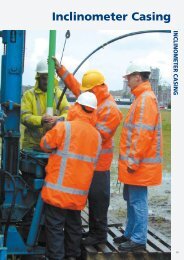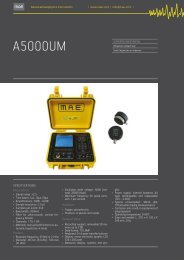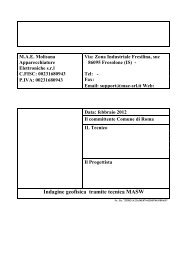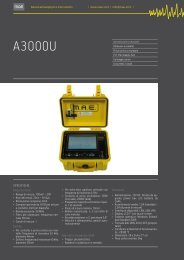Untitled
Untitled
Untitled
You also want an ePaper? Increase the reach of your titles
YUMPU automatically turns print PDFs into web optimized ePapers that Google loves.
› Seismic Explorations<br />
26<br />
› M.A.S.W. (Multichannel Analysis of Surface Waves)<br />
The MASW (Multichannel Analysis of<br />
Surface Waves) technique has the objective<br />
to identify variation profiles<br />
with the depth of the speeds of volume<br />
waves (Vp and Vs). The method<br />
is based on the known relations between<br />
these speeds and the dispersion<br />
of surface (or Rayleigh) waves<br />
observed when propagating through<br />
a stratified elastic medium. The analysis<br />
can be based on signals produced<br />
with a borehole on site by acquisition<br />
device (with a ram or explosion), or on<br />
the recording of the vibrations produced<br />
by far away sources (rives, industrial<br />
activities, traffic, etc).<br />
In the first case, we are talking about<br />
active MASW, with which it is possible<br />
to explore a few tens of metres of<br />
sub-soil, and in the second case, we<br />
are talking about passive MASW, that<br />
allows to reach greater depths, in particular<br />
conditions.<br />
Passive MA.S.W. is used with the purpose<br />
to obtain a speed profile 1D of<br />
the elastic waves of cut S. The technique<br />
consists in the recording of the<br />
“seismic noise” in temporal windows<br />
and following study of the signal<br />
processed. It is carried out by arranging<br />
a bidimensional geophonic chain<br />
with low resonant frequency in line<br />
or in “array” (circular and irregular geometries)<br />
and measuring the environmental<br />
noise. From the F-K analysis<br />
(frequency-space) of the wave-trains,<br />
it is possible to obtain a dispersion<br />
curve of surface waves that leads<br />
to the calculation of the speed profile<br />
of the shear waves and estimate<br />
of a coverage in relation to the semispace.<br />
› S.A.S.W. (Spectral Analysis of Surface Waves)<br />
The Spectral analysis of Surface Waves<br />
SASW allows to determine the speed<br />
profile of the shear waves of a particular<br />
ground. The method is based on<br />
the use of the dispersive properties<br />
of surface waves (Rayleigh) generated<br />
by a surface impulsive input. The<br />
depths explored vary from a few centimetres<br />
(road floors) to a few tens of<br />
metres. SASW is carried out by placing<br />
2 geophones in line, in the ground,<br />
with oscillation frequency from 14<br />
to 1 Hz, and registering the seismograms.<br />
The speeds profile of waves Vs<br />
is obtained from studying the phase<br />
speeds of Rayleigh waves. The data<br />
elaboration consists in determining<br />
the Coherence function, the Cross<br />
Power Spectrum phase and the construction<br />
of the dispersion curves<br />
of the Speed during the experimental<br />
phase in depth. In conclusion, the<br />
propagation phenomenon of the surface<br />
waves is simulated with the purpose<br />
to identify the rigidity profile<br />
reproduced by the experimental dispersion<br />
curve.









